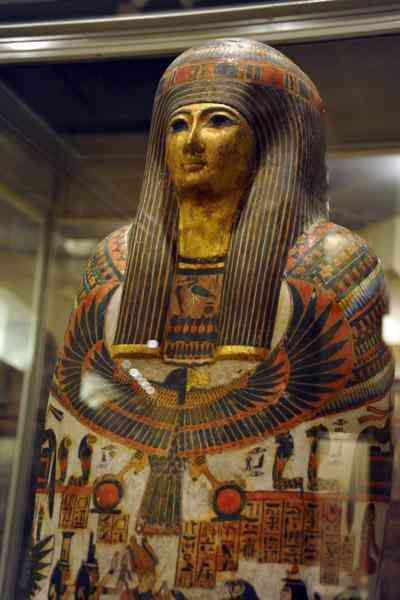Thanksgiving Closure
Grey Roots Museum & Archives will be closed Oct 12, 13 & 14.
Grey Roots Museum & Archives will be closed Oct 12, 13 & 14.

People have long been intrigued with stories of life in Ancient Egypt but they are even more enthralled by stories of their death. From January 18 until May 3, 2014, Grey Roots Museum & Archives hosts the exhibit Egypt: Gift of the Nile. This exhibit is on loan from the Royal Ontario Museum. It explores the many aspects of daily life in these ancient times. There is even has an Egyptian mummy case! This mummiform is made of molded linen with plaster, paint, and gold leaf and is covered with many hieroglyphics and magical symbols. They not only tell the story of the person contained inside, but also provide the body with safe protection as it makes its journey through the underworld on its way to eternal life in the Field of Reeds.
By studying the many hieroglyphics and symbols, Egyptologists have come to know the women whose body was mummified and placed inside. Her name was Djedmaatesankh and she died over 2,800 years ago. She was a middle-class woman living with her husband on the east bank of the Nile River in the town of Thebes. The couple had no children. They were both employed in the Temple of Amun-Re; she as a musician and he as a doorman, prestigious roles to hold in Egyptian society. Being a household with a double income made them highly unusual in that period of time.
Through the wonders of modern technology, we are able to know even more about Djed, as she is often referred to. Under the direction of ROM curator Dr. Nicholas B. Millet and Dr. Peter Lewin, a paediatrician at the Hospital for Sick Children and researcher of ancient diseases, Djemaatesankh underwent a full-body CT-scan while still inside her coffin. The test told them that she probably died of an infected dental cyst in her upper left jaw. The scientists felt that it probably burst allowing the poisons to travel throughout her body. In addition, she had thirteen other smaller abscesses along with extensive dental disease. This information told us that Djed would have lived the latter part of her life in pain. Worn teeth were a common problem in ancient Egypt due to the coarsely ground food of their diet. Much of their food also contained sand which further wore away the enamel of their teeth. Dental cavities were a particular affliction of the wealthy, due to their high consumption of sweetened foods, beer, and honey.
A Toronto police artist studied the mummy’s skull as well as the CT-scan information and was able to draw a picture of what Djedmaatesankh would have looked like in life. The face that looked back from the page was that of a beautiful woman with a strong but kindly face. People now saw more than a mummy, they realized that she had once been a living breathing person who had lived and died in Ancient Egypt.

Your membership will grant you access not only to Grey Roots, but also to our partner museums!

Volunteers participate in learning workshops and seminars, meet new people and make new friends, and receive many benefits.

We rent our multi-media theatre and Delton Becker Room to the community. The 75 seat theatre is an excellent venue to host films, lectures and other events.